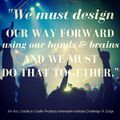File:Cradle to Cradle Products Innovation Instit.jpg: Difference between revisions
Siterunner (talk | contribs) No edit summary |
Siterunner (talk | contribs) No edit summary |
||
| Line 18: | Line 18: | ||
[[Category:Green Graphics]] | [[Category:Green Graphics]] | ||
[[Category:Best | [[Category:Best practice system]] | ||
[[Category:Best Practices]] | [[Category:Best Practices]] | ||
[[Category:Ecology Studies]] | [[Category:Ecology Studies]] | ||
Revision as of 21:32, 12 May 2016
https://twitter.com/hashtag/cradletocradle?src=hash / #cradletocradle
○ ○ ○ ○ ○ ○ ○ ○ ○ ○ ○ ○ ○ ○
https://en.wikipedia.org/wiki/Cradle-to-cradle_design
Cradle to Cradle design (also referred to as Cradle to Cradle, C2C, cradle 2 cradle, or regenerative design) is a biomimetic approach to the design of products and systems. It models human industry on nature's processes viewing materials as nutrients circulating in healthy, safe metabolisms. It suggests that industry must protect and enrich ecosystems and nature's biological metabolism while also maintaining a safe, productive technical metabolism for the high-quality use and circulation of organic and technical nutrients.[1] Put simply, it is a holistic economic, industrial and social framework that seeks to create systems that are not only efficient but also essentially waste free.[2] The model in its broadest sense is not limited to industrial design and manufacturing; it can be applied to many aspects of human civilization such as urban environments, buildings, economics and social systems.
The term Cradle to Cradle is a registered trademark of McDonough Braungart Design Chemistry (MBDC) consultants. Cradle to Cradle product certification began as a proprietary system; however, in 2012 MBDC turned the certification over to an independent non-profit called the Cradle to Cradle Products Innovation Institute. Independence, openness, and transparency are the Institute's first objectives for the certification protocols.[3] The phrase "cradle to cradle" itself was coined by Walter R. Stahel in the 1970s. The current model is based on a system of "lifecycle development" initiated by Michael Braungart and colleagues at the Environmental Protection Encouragement Agency (EPEA) in the 1990s and explored through the publication A Technical Framework for Life-Cycle Assessment.
In 2002, Braungart and William McDonough published a book called Cradle to Cradle: Remaking the Way We Make Things, a manifesto for cradle to cradle design that gives specific details of how to achieve the model.
https://upload.wikimedia.org/wikipedia/commons/0/07/The_Change_in_Sustainability_Framework.jpg
File history
Click on a date/time to view the file as it appeared at that time.
| Date/Time | Thumbnail | Dimensions | User | Comment | |
|---|---|---|---|---|---|
| current | 20:51, 12 May 2016 |  | 600 × 600 (72 KB) | Siterunner (talk | contribs) |
You cannot overwrite this file.
File usage
The following 5 pages use this file: